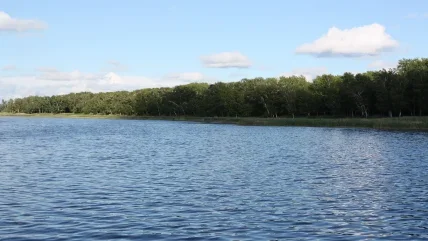
Employees of Russia’s PA Mayak are building a 3D-model of the processes taking place under layers of soil which have been put in place to cover Lake Karachai in the Chelyabinsk region, which is considered the most radioactive body of water in the world. Mayak’s Acting Chief of the ecology service Dmitry Solovyov said the model will show whether there is ground movement or not and the processes occurring under several layers of soil used to backfill the reservoir. It will monitor dose rates, soil shrinkage and the water level in the closed part of the area. "It will allow us to visualise the places where there is a movement of soil in the backfilled reservoir."
Lake Karachai (Lake V-9) is adjacent to the radiochemical plant at the Mayak site, which produces nuclear weapons components and isotopes, and stores and reprocesses used nuclear fuel. When the site was established in the years after World War III and during the early years of the nuclear arms race, secrecy was paramount and safety was not a consideration – a factor common to all the nuclear weapons states at that time. There were no adequate technologies for recycling of radioactive waste, which was dumped directly into the Techa River. For three years (1949-1951) some 3m curies of radionuclides were dumped in this way. In 1951, the discharge was stopped, and the waste was collected in a cascade of reservoirs. After October 1951 Lake Karachai became an open-air storage basin for low- and medium-level liquid radioactive waste a storage facility mainly from Soviet nuclear weapons programmes. When abnormal weather conditions caused the lake to dry out, radioactive dust was blown into the atmosphere.
Work on the conservation of Karachai began in the late 1960s – early1970s. By the mid-1980s a unique technology had been developed for filling the reservoir with rock using hollow concrete blocks. The last stage of the work took place within the framework of the federal target program "Nuclear and Radiation Safety in 2008 and for the period up to 2015" (FTP NRS-1). The ceremony marking the final backfilling of Karachai took place in November 2015.
In December the infilled lake was covered with rock and dirt, effectively transforming it into a near-surface permanent and dry nuclear waste storage facility.
The project cost RUB 17bn ($263m) including the construction of an upland channel to intercept rainfall. Evgeny Makarov, director of Mayak’s radiochemical plant said that over 64 years the lake accumulated discharges about 600m curies of radioactive waste. The lake had become a symbol of the problems associated with "nuclear legacy" in the Russian Federation.
Yuri Mokrova, adviser for science and ecology to Mayak CEO Mikhail Pokhlebaev, noted: "All our focus now is to justify the steps for preservation of Karachai and to transfer it to a new legal status…. This process will take several years. After that, the body of water and its surroundings, as required by law, will be transferred to the national operator for radioactive waste management.” He noted that the work undertaken by Mayak experts to secure the safety of the reservoir “is unique in the world today".
On 23 November, Russian state nuclear corporation Rosatom announced that radiation levels around Karchai had decreased. A statement on Mayak’s website said that monitoring during the first 10 months after sealing off the lake has shown “clear reduction of the deposition of radionuclides on the surface”, while the level of underground waters is “within the norm and shows no reason for concern”. This year, work began to install a system for monitoring underground water, which will be carried out by Mayak and specialised scientific organizations for several decades.






